Are you curious about the number of calories in lunch meat chicken and how it fits into a healthy diet? Making informed choices when it comes to the calories in your lunch meat chicken can have a significant impact on your overall well-being. In this section, we will delve into the topic of calories in lunch meat chicken, exploring how to make healthier choices when it comes to this staple part of your diet.
- Turkey, chicken, and roast beef are the healthiest options for deli meat, as they have fewer additives and preservatives compared to processed meats like salami, bologna, and pepperoni.
- When choosing deli meat, opt for fresh sliced meat from the counter or pre-packaged options with limited ingredients and no artificial colors.
- Nitrate-free and deli meat free of artificial colors are recommended for a healthier choice.
- While deli meat can be a source of protein, it should be consumed in moderation due to preservatives, natural flavors, and high sodium content.
- Pregnant individuals should heat deli meat to kill any potential bacteria.
By understanding the nutritional facts of chicken lunch meat and making informed choices, you can enjoy this protein source while maintaining a healthy diet. Stay tuned as we explore the nutrient composition, health benefits, and considerations associated with chicken lunch meat in the upcoming sections.
Understanding the Nutritional Facts of Chicken Lunch Meat
Let’s take a closer look at the nutritional facts of chicken lunch meat and gain a better understanding of its calorie content. When it comes to deli meats, chicken is often a popular choice due to its lean and versatile nature. It is important to be aware of the nutritional information to make informed choices for a balanced diet.
Chicken lunch meat is generally low in fat and calories compared to other deli meats. A typical serving size of 3 ounces contains around 100-120 calories, making it a relatively light option. It is also a good source of protein, providing essential amino acids that support muscle growth and repair.
When examining the nutritional label of chicken lunch meat, it is crucial to consider sodium content. Processed meats, including deli meats, are known to be higher in sodium. Opting for low-sodium or reduced-sodium varieties can help manage sodium intake, especially for individuals with high blood pressure or other health concerns.
To further illustrate the nutritional value of chicken lunch meat, here is a table summarizing its key nutritional information:
| Nutrient | Amount per serving (3 oz) |
|---|---|
| Calories | 100-120 |
| Total Fat | 2-4 grams |
| Protein | 18-22 grams |
| Sodium | 450-600 milligrams |
By being mindful of portion sizes and considering the overall nutritional profile, chicken lunch meat can be a nutritious and delicious addition to your diet. It is important to pair it with other nutritious foods, such as whole grains, vegetables, and fruits, to create a well-rounded meal.

Remember, moderation is key when it comes to processed meats. While chicken lunch meat can be a convenient and tasty option, it is advisable to balance it with fresh and minimally processed foods for optimal health. As always, consulting with a healthcare professional or registered dietitian can provide personalized guidance based on your specific dietary needs and goals.
Health Benefits of Chicken Lunch Meat
Did you know that chicken lunch meat offers more than just a delicious taste? Let’s explore its health benefits and nutritional value. Chicken lunch meat is a popular choice for sandwiches and salads, and it’s not just because of its convenience. This lean protein source is packed with essential nutrients that can support your overall well-being.
One of the key health benefits of chicken lunch meat is its low calorie count. Compared to other deli meats, chicken lunch meat tends to have fewer calories per serving, making it a great option for those watching their calorie intake. Additionally, chicken lunch meat is low in fat, particularly if you opt for skinless breast meat. This can help you maintain a healthy weight and reduce the risk of heart disease.
Chicken lunch meat is also a good source of important vitamins and minerals. It contains B vitamins, including niacin and vitamin B6, which play a vital role in energy production and brain function. Additionally, chicken lunch meat is rich in iron, which is essential for red blood cell formation and oxygen transportation throughout the body.
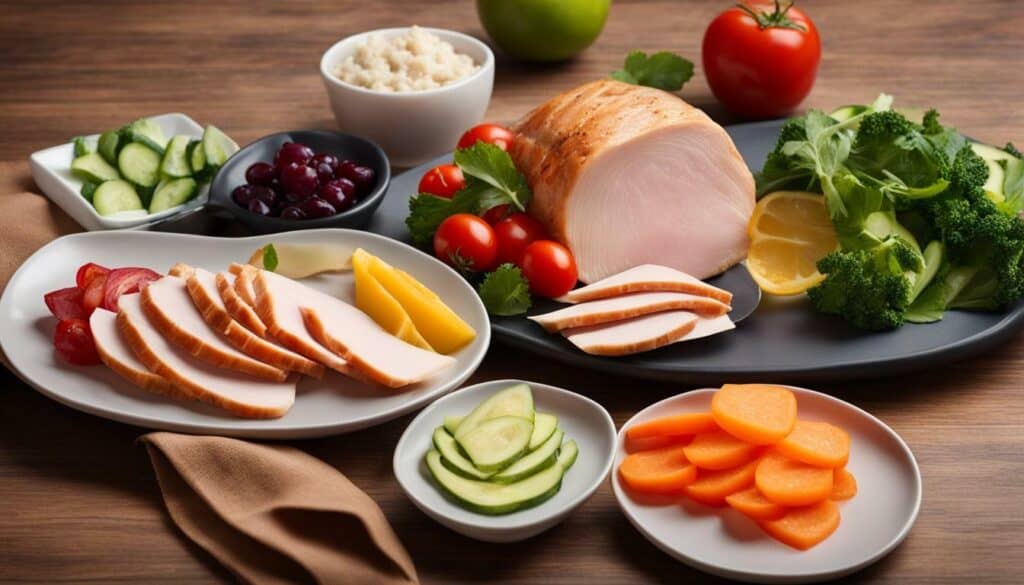
When choosing chicken lunch meat, it’s important to be mindful of the sodium content. Some processed varieties may contain higher levels of sodium, which can contribute to high blood pressure. Opt for low-sodium options whenever possible or limit your consumption to maintain a healthy sodium intake. And don’t forget to read the labels carefully to make sure you’re choosing chicken lunch meat with limited additives and preservatives.
In conclusion, chicken lunch meat provides a range of health benefits and can be a nutritious addition to your diet. It offers a lean source of protein, vitamins, and minerals while being relatively low in calories and fat. Just remember to choose chicken lunch meat with minimal additives and moderate your intake to maintain a balanced diet. So why not enjoy the delicious taste of chicken lunch meat while reaping its health benefits?
Comparing Chicken Lunch Meat to Other Deli Meats
When it comes to deli meats, how does chicken lunch meat stack up against other options in terms of calorie content and serving size? Let’s take a closer look at the nutritional profiles of chicken lunch meat and compare it to some popular alternatives.
| Deli Meat | Calories per Serving | Serving Size |
|---|---|---|
| Chicken Lunch Meat | 60 | 2 ounces |
| Turkey Lunch Meat | 50 | 2 ounces |
| Roast Beef | 70 | 2 ounces |
| Salami | 120 | 2 ounces |
| Bologna | 150 | 2 ounces |
As we can see from the table above, chicken lunch meat is a relatively low-calorie option compared to salami and bologna. With only 60 calories per 2-ounce serving, it offers a lighter alternative for those watching their calorie intake. Turkey lunch meat is even lower in calories at just 50 calories per serving, making it another healthy choice.
In terms of serving size, chicken lunch meat, turkey lunch meat, and roast beef all have the same recommended 2-ounce portion. This can make it easier to portion out your deli meat and keep track of your calorie intake. However, it’s worth noting that the calorie content can vary depending on the brand and preparation method, so always check the nutrition label for accurate information.
When it comes to making healthier choices for deli meats, opting for lean options like chicken lunch meat can be a smart move. Its lower calorie content and moderate serving size make it a great choice for those looking to watch their weight or maintain a healthy lifestyle.
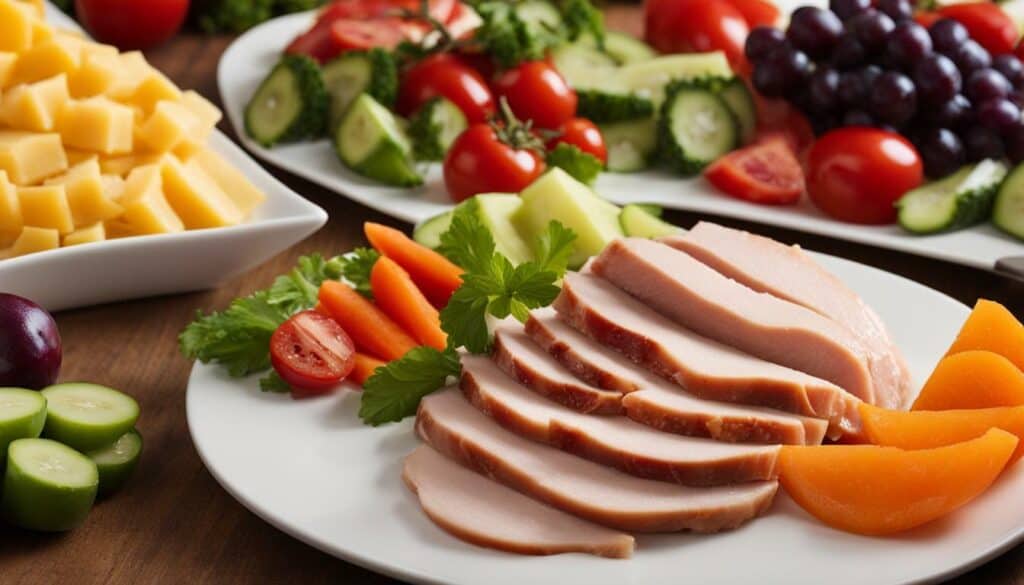
“Choosing lean deli meats like chicken lunch meat can help you meet your dietary goals without sacrificing flavor. It’s important to balance your protein intake and be mindful of portion sizes to maintain a healthy diet.”
Choosing Healthier Options for Deli Meat
There are ways to make healthier choices when it comes to deli meat, including chicken lunch meat. Let’s explore some strategies to help you stay on track with your health goals.
Firstly, opt for fresh sliced deli meat at the counter or choose pre-packaged options with limited ingredients and no artificial colors. These choices are typically lower in sodium and have fewer additives and preservatives compared to processed meats like salami or bologna. Look for nitrate-free and deli meat free of artificial colors for an even healthier choice.
When it comes to beef, leaner cuts can be found in the hip or hindquarter regions with keywords like “round” or “loin.” Grass-fed beef may be lower in fat and higher in heart-healthy omega-3 fatty acids. If you’re looking for an alternative to beef, consider bison, which is leaner and contains less fat and calories, although it is not graded by the USDA.
Poultry, such as chicken and turkey, can be a healthier alternative to red meat. Opt for skinless breast meat for the leanest option, or choose dark meat for more B vitamins and iron. Be mindful of sodium content in marinated, frozen, or canned poultry. Turkey bacon is often recommended over pork bacon, but it can contain more sodium. And if you’re a fan of pork, look for cuts like pork tenderloin, which can be low in fat and high in protein. Lean pork also contains higher amounts of thiamine, niacin, and vitamins B-6 and B-12 compared to other meats.

- Choose fresh sliced deli meat or pre-packaged options with limited ingredients and no artificial colors.
- Opt for leaner cuts of beef like those from the hip or hindquarter regions, or consider bison as a leaner alternative.
- When it comes to poultry, go for skinless breast meat for the leanest option or choose dark meat for added B vitamins and iron.
- Be mindful of sodium content in marinated, frozen, or canned poultry, and opt for turkey bacon over pork bacon if watching sodium intake.
- Lean cuts of pork, such as pork tenderloin, can be low in fat and high in protein.
- Processed meats like sausage and hot dogs should be consumed sparingly.
| Deli Meat | Calories per Ounce |
|---|---|
| Chicken Lunch Meat | 30 |
| Turkey | 29 |
| Roast Beef | 50 |
| Salami | 103 |
| Bologna | 87 |
Addressing Concerns and Considerations
Before incorporating chicken lunch meat into your diet, it’s important to address some concerns and considerations to ensure it aligns with your health goals. While chicken lunch meat can be a convenient and tasty protein option, there are a few things to keep in mind.
Firstly, it’s crucial to pay attention to the nutritional information and ingredient list of the chicken lunch meat you choose. Look for options that are low in sodium, free of artificial colors, and have limited additives and preservatives. Opting for nitrate-free varieties can also be beneficial, as nitrates have been linked to certain health risks when consumed in excess.
Additionally, if you’re following a specific dietary plan or have certain health conditions, it’s essential to consider how chicken lunch meat fits into your overall meal plan. For example, if you’re watching your sodium intake, be mindful of the sodium content in deli meats, as they can be high. If you have specific dietary restrictions or are on a low-carb or low-fat diet, be sure to choose chicken lunch meat options that align with those requirements.
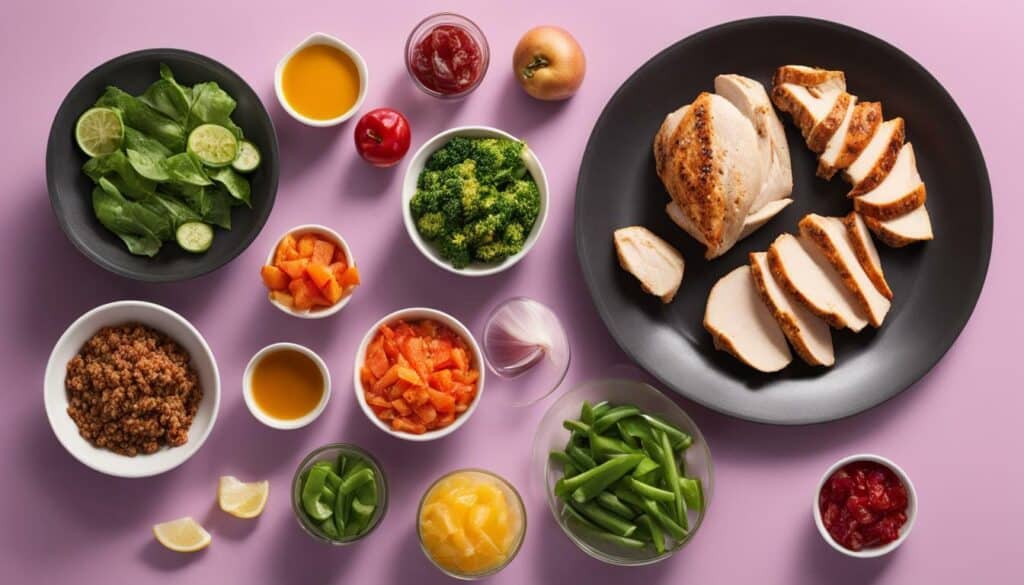
Understanding the Nutritional Value of Chicken Lunch Meat
| Nutrient | Amount per Serving |
|---|---|
| Calories | 70 |
| Total Fat | 2g |
| Cholesterol | 25mg |
| Sodium | 400mg |
| Protein | 10g |
As shown in the table above, chicken lunch meat is relatively low in calories and fat while being a good source of protein. However, it’s important to be mindful of the sodium content, as it can vary depending on the brand and preparation method. If you’re watching your sodium intake or have high blood pressure, it may be advisable to limit your consumption or opt for lower sodium varieties.
Finally, always ensure proper storage and handling of chicken lunch meat to prevent the growth of harmful bacteria. Store it in the refrigerator at or below 40°F (4°C) and consume it within a few days of opening. If the meat has an off smell or appearance, it’s best to discard it to avoid any potential foodborne illnesses.
In conclusion, while chicken lunch meat can be a convenient and tasty protein option, it’s important to address concerns and considerations such as sodium content, nutritional value, and individual dietary needs. By making informed choices and incorporating chicken lunch meat in moderation, you can enjoy its benefits as part of a healthy and balanced diet.
Chicken Lunch Meat and Pregnancy
If you’re pregnant and considering chicken lunch meat as part of your diet, there are a few things to keep in mind to ensure the safety of you and your baby. Chicken lunch meat can be a convenient and tasty option, but it’s important to take precautions due to the risk of foodborne illnesses, such as listeria.
To minimize the risk, it is recommended to heat chicken lunch meat until it is steaming hot before consuming it. Heating the meat helps kill any potential bacteria that may be present. You can do this by microwaving the sliced chicken lunch meat or heating it in a skillet until it reaches an internal temperature of at least 165°F (74°C).
Additionally, it’s crucial to store chicken lunch meat properly to prevent bacterial growth. Make sure to refrigerate it at or below 40°F (4°C) and consume it within a few days of purchase. If the lunch meat appears slimy, discolored, or has an off smell, it’s best to discard it to avoid any potential risks.
Remember, the health and safety of you and your baby are of utmost importance during pregnancy. By following these guidelines and practicing food safety measures, you can still enjoy chicken lunch meat as part of a balanced diet while minimizing potential risks.
| Lunch Meat Type | Calories per Serving |
|---|---|
| Chicken Lunch Meat | 60 |
| Turkey Lunch Meat | 50 |
| Ham Lunch Meat | 90 |
| Roast Beef Lunch Meat | 70 |
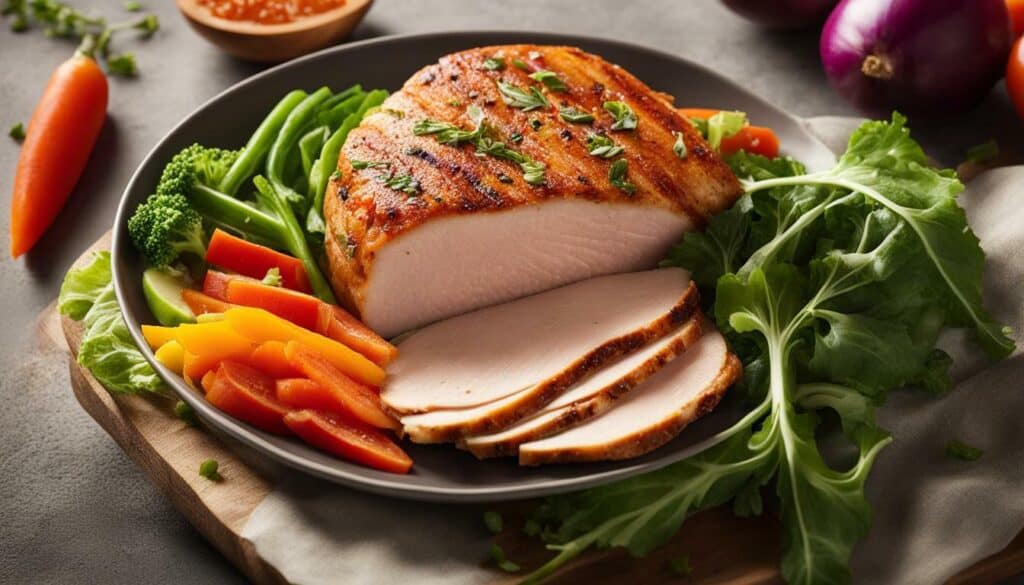
In conclusion, chicken lunch meat can be enjoyed by pregnant individuals as long as proper precautions are taken. Heating the meat until it is steaming hot and storing it correctly are essential steps in ensuring food safety. By following these guidelines, you can continue to include chicken lunch meat in your diet while considering the needs of both you and your baby.
Exploring Different Protein Sources
While chicken lunch meat can be a convenient protein source, it’s always good to explore other options. Let’s discover some alternative sources of protein and their calorie content.
One popular choice is turkey, which is lean and low in fat. It contains fewer additives and preservatives compared to other deli meats. A 3-ounce serving of turkey lunch meat contains approximately 90 calories, making it a healthier option. Turkey is also rich in vitamins B6 and B12, which are essential for energy metabolism and brain function.
Another alternative is roast beef, which is known for its rich flavor and tenderness. It is a good source of protein, iron, and zinc. A 3-ounce serving of lean roast beef contains approximately 150 calories. It’s important to choose lean cuts of roast beef to keep the calorie content in check.
If you’re looking for a change from poultry and beef, seafood can be a great option. Fish such as salmon and tuna are rich in omega-3 fatty acids, which are beneficial for heart health. Additionally, seafood is generally low in calories and high in protein. A 3-ounce serving of grilled salmon contains approximately 200 calories, while a 3-ounce serving of canned tuna in water contains around 100 calories.
| Protein Source | Calories per 3-ounce serving |
|---|---|
| Turkey | 90 |
| Roast Beef | 150 |
| Grilled Salmon | 200 |
| Canned Tuna (in water) | 100 |
As you can see, there are plenty of delicious and nutritious protein sources to choose from. Whether you prefer turkey, roast beef, or seafood, these alternatives can provide you with the protein your body needs without sacrificing taste or health.
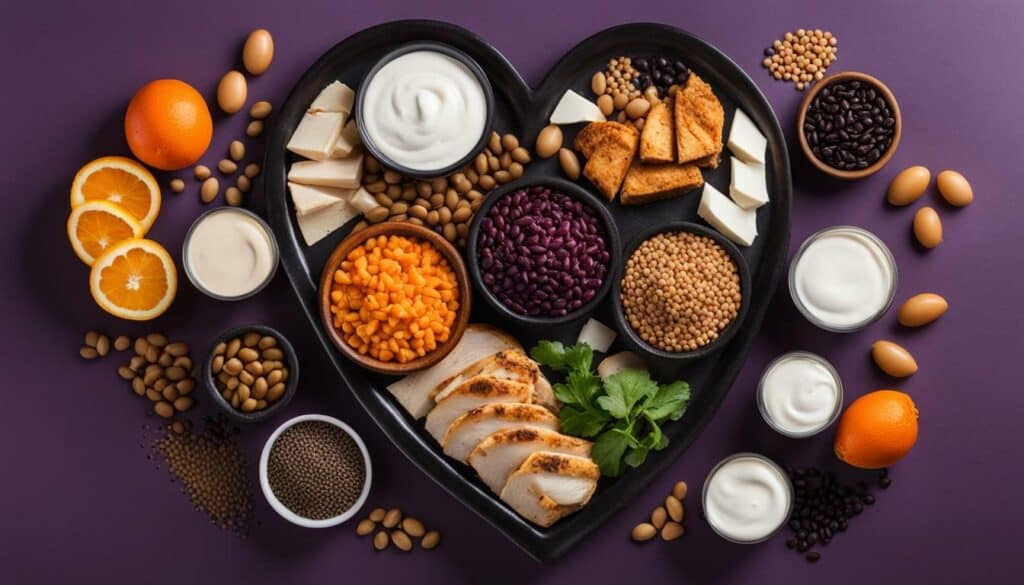
Remember, while chicken lunch meat can be a convenient option, it’s important to vary your protein sources to ensure you’re getting a wide range of nutrients. Experiment with different options and find what works best for your taste preferences and dietary needs.
Leaner Meat Choices and Their Benefits
While chicken lunch meat can be a healthier choice compared to some other deli meats, there are even leaner options available. Let’s explore the nutritional benefits of turkey and roast beef.

When it comes to deli meat, the healthiest options are turkey, chicken, or roast beef. These meats have fewer additives and preservatives compared to salami, bologna, pepperoni, and pastrami, which are higher in sodium and more processed. It’s best to get deli meat fresh sliced at the counter, or choose pre-packaged options with limited ingredients and no artificial colors. Nitrate-free and deli meat free of artificial colors are also recommended.
| Meat Type | Benefits |
|---|---|
| Turkey | Lean source of protein, low in fat and cholesterol |
| Roast Beef | High in protein, iron, and zinc, low in saturated fat |
While deli meat can be a source of protein, it should be consumed in moderation due to preservatives, natural flavors, and high sodium content. For pregnant individuals, it is advised to heat deli meat to kill any potential bacteria.
Beef Options
When it comes to beef, leaner cuts are found in the hip or hindquarter region with keywords like “round” or “loin.” Grass-fed beef may be lower in fat and higher in heart-healthy omega-3 fatty acids. Bison is leaner than beef and contains less fat and calories, but it is not graded by the USDA.
Key Takeaway: Choose turkey or roast beef for a leaner choice of deli meat, and opt for fresh sliced or pre-packaged options with limited ingredients and no artificial colors. Remember to consume deli meat in moderation and heat it properly if you’re pregnant.
Conclusion
Making informed choices about the calories in lunch meat chicken and other deli meats is crucial to maintaining a healthy and balanced diet. When it comes to deli meat, the healthiest options are turkey, chicken, or roast beef. These meats have fewer additives and preservatives compared to salami, bologna, pepperoni, and pastrami, which are higher in sodium and more processed.
If you’re buying deli meat, it’s best to get it fresh sliced at the counter, or choose pre-packaged options with limited ingredients and no artificial colors. Look for nitrate-free and deli meat free of artificial colors. While deli meat can be a source of protein, it should be consumed in moderation due to preservatives, natural flavors, and high sodium content.
For pregnant individuals, it is advised to heat deli meat to kill any potential bacteria. When it comes to beef, leaner cuts are found in the hip or hindquarter region with keywords like “round” or “loin.” Grass-fed beef may be lower in fat and higher in heart-healthy omega-3 fatty acids. Bison is leaner than beef and contains less fat and calories, but it is not graded by the USDA.
Poultry, such as chicken and turkey, can be a healthier alternative to red meat. Skinless breast meat is the leanest, while dark meat contains more B vitamins and iron. It’s important to watch sodium content in marinated, frozen, or canned poultry. Turkey bacon is often recommended over pork bacon, but it can contain more sodium. Pork cuts, like pork tenderloin, can be low in fat and high in protein. Lean pork contains higher amounts of thiamine, niacin, and vitamins B-6 and B-12 compared to other meats. Processed meats, like sausage and hot dogs, should be consumed sparingly.
FAQ
Q: Are turkey and chicken healthier options for deli meat compared to salami and pepperoni?
A: Yes, turkey and chicken are generally considered healthier options for deli meat. They have fewer additives and preservatives compared to salami and pepperoni, which are higher in sodium and more processed.
Q: Is it better to get deli meat fresh sliced at the counter or choose pre-packaged options?
A: It’s best to get deli meat fresh sliced at the counter or choose pre-packaged options with limited ingredients and no artificial colors. This way, you can ensure the freshness and quality of the meat.
Q: Is nitrate-free and deli meat free of artificial colors recommended?
A: Yes, nitrate-free and deli meat free of artificial colors are recommended for a healthier choice. These options have fewer artificial additives and preservatives.
Q: Should deli meat be consumed in moderation?
A: Yes, deli meat should be consumed in moderation due to the presence of preservatives, natural flavors, and high sodium content.
Q: How should deli meat be prepared during pregnancy?
A: For pregnant individuals, it is advised to heat deli meat to kill any potential bacteria. This can be done by heating the meat until it is steaming hot.
Q: What are some leaner beef cuts for a healthier choice?
A: Leaner beef cuts are found in the hip or hindquarter region with keywords like “round” or “loin.” Grass-fed beef may also be lower in fat and higher in heart-healthy omega-3 fatty acids.
Q: Is poultry a healthier alternative to red meat?
A: Yes, poultry, such as chicken and turkey, can be a healthier alternative to red meat. Skinless breast meat is the leanest, while dark meat contains more B vitamins and iron.
Q: What should I watch out for in marinated, frozen, or canned poultry?
A: It’s important to watch sodium content in marinated, frozen, or canned poultry. These varieties may have higher sodium levels compared to fresh, unseasoned poultry.
Q: Is turkey bacon a healthier option compared to pork bacon?
A: Turkey bacon is often recommended over pork bacon, but it can still contain more sodium. It’s important to read the nutrition labels and choose lower sodium options.
Q: What are the nutritional advantages of lean pork cuts?
A: Lean pork cuts, like pork tenderloin, can be low in fat and high in protein. They also contain higher amounts of thiamine, niacin, and vitamins B-6 and B-12 compared to other meats.
Q: How should processed meats be consumed?
A: Processed meats, like sausage and hot dogs, should be consumed sparingly due to their higher sodium and preservative content.

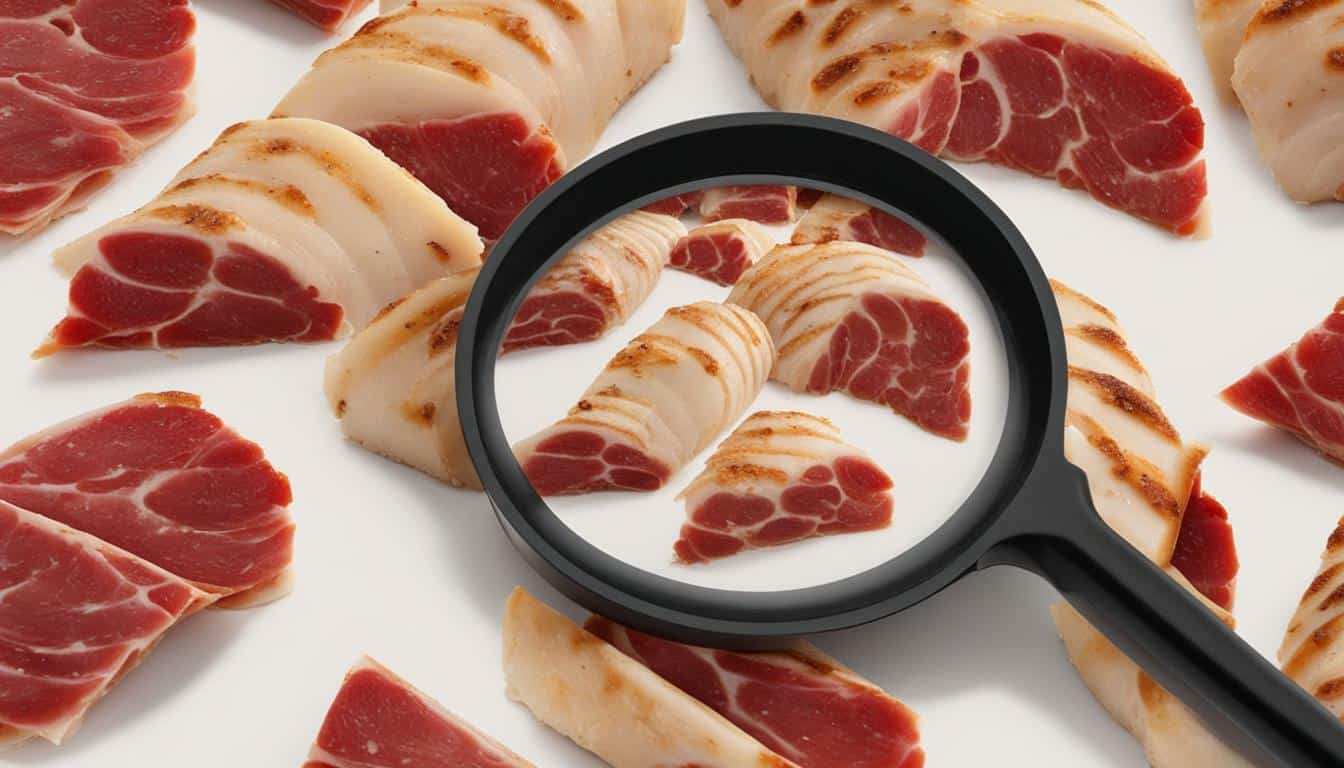



Leave a Reply